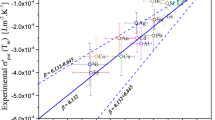Abstract
The sensitivity (response) of six semiconducting metal oxide (SMO) structures on the basis of SnO2 to water vapor was studied in dry and humid air over the H2O vapor concentration range 0–2.9 vol % (0–100% RH) as the temperature of the samples changed from 200 to 600°C. The temperature dependence of the conductivity and response of SMOs to H2O vapor had extrema at 300–400 and 250–400°C, respectively, and the sensitivity to water vapor did not decrease below 1.7–1.9 up to 600°C. Data on changes in the conductivity of SMOs and the number of OH− groups in the oxygen-hydroxyl layer on the surface of SMOs depending on temperature and air humidity were obtained. A sharp change in conductivity as air humidity increased from 0 to 10% RH could be related to either a sharp change in the number of OH− groups in the oxygen-hydroxyl layer because of the high polarity of water molecules or a decrease in the intergrain energy barrier. The phenomena observed and the behavior of SMO conductivity in dry and humid air were interpreted. The experimental data were used to suggest a mechanism of the formation of hydroxyl groups on the surface of SMOs. The paper contains practical recommendations concerning the temperature conditions under which the influence of humidity on changes in the conductivity of SMOs is weakest.
Similar content being viewed by others
References
F. F. Vol’kenshtein, Electronic Processes on Semiconductor Surfaces in Chemisorption (Nauka, Moscow, 1987) [in Russian].
V. F. Kiselev, Surface Phenomena in Semiconductors and Dielectrics (Nauka, Moscow, 1970) [in Russian].
Semiconductors, Ed. by N. B. Hannay (Reinhold, New York, 1959; Inostrannaya Literatura, Moscow, 1962).
V. F. Kiselev and O. V. Krylov, Electronic Phenomena in Adsorption and Catalysis on Semiconductors and Dielectrics (Nauka, Novosibirsk, 1979) [in Russian].
B. Ruhland, T. Becker, and G. Muller, Sens. Actuators, B 50, 85 (1998).
V. V. Malyshev, A. V. Pislyakov, I. F. Krestnikov, et al., Zh. Anal. Khim. 56(9), 976 (2001) [J. Anal. Chem. 56 (9), 864 (2001)].
Tables of Physical Values: A Handbook, Ed. by I. K. Kikoin (Atomizdat, Moscow, 1976) [in Russian].
J. Kappler, N. Barsan, U. Weimar, and W. Gopel, in Proceedings of 11th European Conference on Solid State and Transducers (Warsaw, 1997), p. 1117.
W. Göpel and G. Reinhardt, in Sensors Update Sensor Technology — Applications — Markets, Ed. by H. Baltes, W. Göpel, and J. Hesse (VCH, Weinheim, 1996), Vol. 1, pp. 49–120.
G. Martinelli and M. C. Carrota, Sens. Actuators, B 23, 157 (1995).
G. Ghiotti, A. Chiorino, G. Martinelli, and M. C. Carotta, Sens. Actuators, B 24–25, 520 (1995).
Sensors: A Comprehensive Survey, Ed. by W. Göpel, J. Hesse, and J. N. Zemel, Vol. 2: Chemical and Biochemical Sensors. Part I, Ed. by W. Göpel, T. A. Jones, M. Kleitz, et al. (VCH, Weinheim, 1991).
V. V. Malyshev and A. V. Pislyakov, Sens. Actuators, B 123, 71 (2007).
V. V. Malyshev and A. V. Pislyakov, Datchiki Sistemy, No. 8, 46 (2000).
V. V. Malyshev and A. V. Pislyakov, Sens. Actuators, B 96, 413 (2003).
H. Remy, Treatise on Inorganic Chemistry (Van Nostrand, New York, 1956; Inostrannaya Literatura, Moscow, 1960), Vol. 1.
Chemical Encyclopedia (Sovetskaya Entsiklopediya, Moscow, 1988), Vol. 1 [in Russian].
G. P. Khomchenko and I. K. Tsitovich, Inorganic Chemistry (Vysshaya shkola, Moscow, 1987) [in Russian].
Physical Encyclopedia (Sovetskaya Entsiklopediya, Moscow, 1988), Vol. 1 [in Russian].
C. G. Fonstad and R. H. J. Rediker, Appl. Phys. 42(7), 2911 (1971).
Physical Encyclopedia (Bol’shaya Rossiiskaya Entsiklopediya, Moscow, 1992), Vol. 3 [in Russian].
R. B. Vasil’ev, L. I. Ryabova, M. N. Rumyantseva, and A. M. Gas’kov, Usp. Khim. 73(10), 1019 (2004).
Author information
Authors and Affiliations
Corresponding author
Rights and permissions
About this article
Cite this article
Malyshev, V.V. Response of semiconducting metal oxides to water vapor as a result of water molecules chemical transformations on catalytically active surfaces. Russ. J. Phys. Chem. 82, 2329–2339 (2008). https://doi.org/10.1134/S0036024408130293
Received:
Published:
Issue Date:
DOI: https://doi.org/10.1134/S0036024408130293



